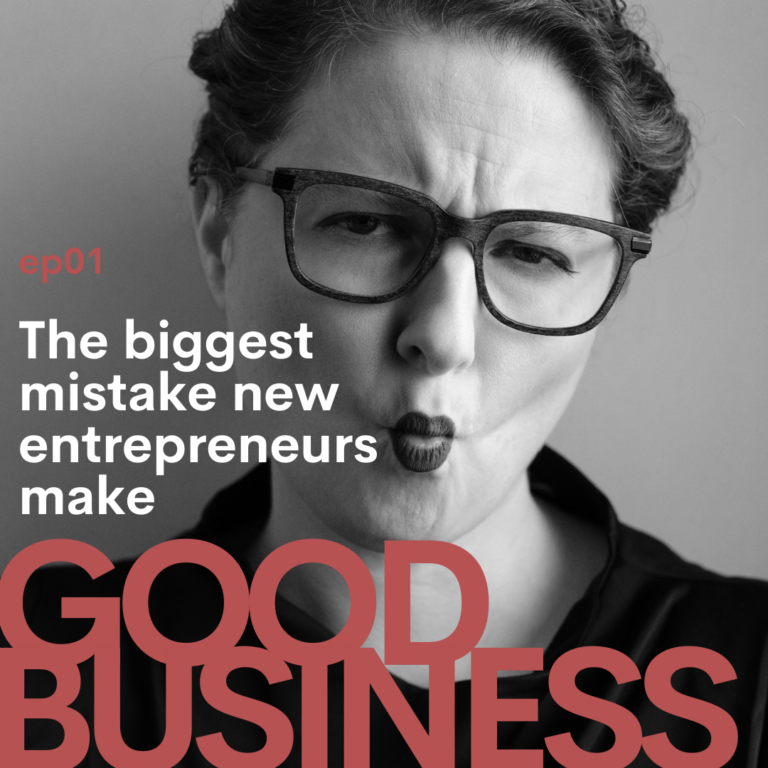Episode Transcript:
I’m Illana Burk, CEO of Your Life’s Workshop, coach to entrepreneurs and solopreneurs across dozens of industries and host of Good Business. With nearly 20 years experience helping hundreds of clients create profitable, ethically driven and sustainable businesses based on their life’s work, I’m here to teach you how to do great work, make great money, and make a positive impact without feeling like you need a shower afterwards.
Hi everybody. Today we’re talking about why trust building beats list building every day of the week. So first up we’re going to talk about why focusing on list building as your primary focus in client acquisition is the very best way to feel like you are banging your head against a wall. It’s also the very best way to make the people you most want to connect with feel like the only thing that matters to you about them is their email address. So to begin, we’re going to talk about why people focus on list building. Then, we’re going to talk about why focusing on trust-building is a way more, is way more sustainable as a long-term plan.
So first, list building. Some of you may not even know what I’m talking about when I say list building. So for those of you that don’t work in the online business space, I’ll explain it a little bit — a quick primer. List building is the process and associated actions that entrepreneurs and marketers take to build an email list. It used to be simple, you create a free report or a white paper or something and give it away as an incentive to fork over your email address. It was an easy exchange, not a big deal, but things are not that simple anymore. Now there are auto-responders and tripwires and selling cycles and sales pages and funnels and long-form sales pages and nurture campaigns. The list goes on and on of all the different things that you can give away. We’d be here all day. But the components needed and the technical know-how in order to do all of this is based on psychology. I mean, it’s a huge project. So the basic idea, though, is that a huge chunk of your energy goes towards getting people on your email list so that you can sell them things again and again and again and again and again. An activated list will keep buying from you over and over and over again is the theory and is pretty true but not the whole story.
Let me start by saying three things. First, I am way biased on this topic. I have been running a business for 11 years now and have never focused any energy at all on list building. I make great money, and I have an embarrassingly small email list. If you’re on it, you’re going, “Yeah, I don’t remember the last time Illana sent me something.” That’s because I hardly ever send anything out. That will probably change in the future as I have a desire to grow, but thus far, my business has thrived without it. So that’s thing number one.
Thing number two is you only need to build a list if you need to build a list. Which means if you need volume to make a living, then you need a list, but not everyone does. So before you worry about whether you need to build a list, you need to know what your revenue model is. Because if you only need four people in order to fill your client roster, then you don’t need to build a list because it won’t be that hard to find four people. If you need 400 people, then yeah, you’re going to need to build a list.
Third, I am not against list building at all. It’s a super useful tool and a necessity for a multitude of businesses that rely on community building in order to thrive. I’m not bashing list building here. I’m not saying why you shouldn’t do it. I’m saying why it’s not the end all be all, and when you’re starting up a new business, it gets really, really easy to think that that’s how you should be spending a significant chunk of your time. And it just might not be. So building a list is basically a full-time job these days. If you’re going to do it, you better make sure that you actually need to. While most businesses will need to list build at some point, they might not be at that point.
So why not list build? What are the downsides? First, if you have built a leadership voice for yourself, then the tactics you need to employ can come across as sales first, care and helpfulness second, which is not generally the sort of thing that you want if you want people to just trust and hire you. Especially when you’re just starting. So I’m going to say that again. If you want to build trust, if you want people to think that you are a pro at what you do and not at just building your list and being a marketer, then list building and the tactics involved with it can be counterproductive.
So second, it’s really, really, really fucking hard. It takes a ton of time and energy. It has a steep learning curve to be effective. It also takes money these days. It’s not just diamond mg. It takes money to build and unless you absolutely nail it and have a super-strong brand to back it up, meaning, all of the things that you need, meaning, a constant newsletter and support and customer service and all the various things that then leverage a list, then it simply won’t even work. Then third, again, it might be unnecessary. If you only need a handful of clients, then getting hundreds of thousands of people to hang on your every newsletter is a giant waste of energy and resources. So why bother?
What does it mean to focus on trust-building instead? First, it means that you value every interaction that you have in a business or personal context like it’s gold like it’s a potential client or someone who might know someone who could be a potential client. You take however much time you need to nurture the connections that you have. It means that when you get a sales call opportunity, you don’t do it in 15 minutes. You spend an hour with somebody answering every possible question they have and giving them a slice of what you do. So second, it means that you focus on being of service in literally any way you can, money or not. So if you want to build trust, you help. That’s it. Help first. Offer to help where and however you can. It doesn’t mean turning yourself into a doormat, people. If you’re a budding web designer, you don’t say, “Yes, I’ll do it for free,” for every freaking person that you see on Facebook that needs a website. You say, “Hey, I’m looking to build my portfolio. You’re looking for a website, you can’t afford much, and I need to build my portfolio. So how can we make this work for both of us? I’d be more than happy to give you a long payment plan and make this, give you a steep discount so that we can do a situation that’s a win-win for both of us.” That’s what I mean by helpfulness. It means giving somebody advice if you had the answer. Give it for free. It’s not going to cost you anything, and it’s only going make people trust you and think that you’re fantastic.
So third, it means that you put energy and resources into showing the people who are in your community, what you’re made of. Find your voice, show it off. Learn what it means to have the courage of your convictions. Produce content that matters to the people you most want to help and do it again and again and again and again, until people start paying attention. Because if you keep doing that and you keep showing up, eventually you start to come across as trustworthy because stability equals trust from a public standpoint. So showing up over and over and over again and saying the same thing and having the same message and the courage of your convictions means that people will pay attention and begin to listen.
Consider this your permission to think hard about whether or not you need to bang your head against the, “I must create the perfect opt-in,” wall if it’s not the right thing for your business.
So what are your next steps? First, think hard about your revenue model. Does your income come from a few well-paying clients? Or does it come from a thousand people buying a course for 50 bucks a piece? Do you see yourself leading a movement or providing service one-on-one? How does your revenue model align with who you are as a human being and where you want to end up?
The big lesson here is to build the audience that you need to have the business that you want. That can be 10 people, or it can be 10,000. Don’t let anybody else tell you what it should be or what it has to be or what it needs to be. One more time – build the audience that you need to have the business that you want. That’s it.
Alrighty. Bye, everybody. Thanks for joining me. Have a great week. See y’all soon.
Thanks so much for hanging out with me today. For more information, visit www.thegood business.co or www.lifesworksdev.wpengine.com.
More Episodes
The BIGGEST mistake new entrepreneurs make | GB01
So it turns out that your business is not about you. It's about the people you most want to serve. Today we explore how (and why) to set your ego aside so you can build your business based on the RIGHT factors, rather than your...

